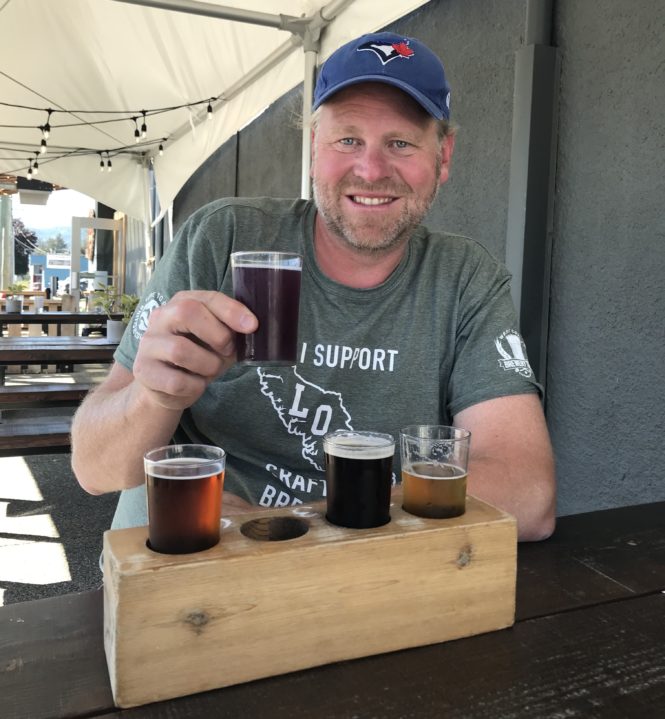Ask a beer lover what their favourite is, and odds are they’ll pick something on the extreme edge of the flavour spectrum: a hoppy/hazy IPA, tart sour, or barrel-aged imperial stout. Rarely will a lager make it on to a beer geek’s bucket list.
I think lagers are underappreciated, and I’ve enlisted the help of two brewers who have a serious case of #LagerLove themselves: Conrad Gmoser (Brassneck Brewery) and Sean Hoyne (Hoyne Brewing).
Sean Hoyne agrees that “lagers have always been underrepresented in the craft beer world.” When he started brewing at Swans Brewpub in 1989, his mentor Frank Appleton designed recipes for several different English-style ales, but as soon as Hoyne could, he “got some yeast from a brewery in Munich and some German and Czech hops” and brewed Old Towne Bavarian Lager, which became a staple on the Swans lineup for many years.

He continued to brew lagers when he moved over to Canoe Brewpub a few years later, and then when he opened his own brewery in 2011, he says, “It wasn’t even an option for me to not make a pilsner.” This despite the fact that lagers take longer to brew, which is why many new breweries abstain from brewing lagers until they can expand their tank capacity.
Hoyne’s most popular beers, Hoyne Pilsner (5.5% ABV) and Dark Matter (5.3% ABV), are both lagers. Over the years, Hoyne has also added Helios Golden Lager (6% ABV) and Vienna Lager (5.3% ABV; previously called Off the Grid) to his lager lineup.
Hoyne loves researching the history of beers, and he feels like he is “standing on the shoulders of giants” when he brews a beer correctly according to style. For lagers, that means using region-specific ingredients and aging the beer properly, not rushing it to open up tank space. Hoyne orders container loads of German malts and specific Czech and German hops to ensure they taste correct.
Helios is my favourite of Hoyne’s lagers. A Dortmunder Export style, it’s slightly stronger than a Pilsner with a complex malt character. According to Hoyne, it was made to quench the thirst of coal miners in the Dortmund region of Germany and then became so popular that the brewers developed an export version that was slightly stronger than the local one.
“At one point,” Hoyne says, “It was the biggest selling style in continental Europe.”
To Hoyne, lagers are about subtlety.
“If ales are about making them bigger than everyone else’s then lagers are about making them better than everyone else’s.”
Over at Brassneck, Conrad Gmoser agrees.
“Lagers are tough,” he says. “You can’t really knock it out of the park. They’re way more about balance. You don’t have much to hide behind if there are flaws in the lager.”
When Gmoser first started at Steamworks in the mid-1990s, he says, “I had a lot of respect for lager so I was worried about doing it well and making enough.” With the smaller brewpub system it was challenging to let a lager age long enough, but he was rewarded for his diligence when his pilsner was named B.C.’s Beer of the Year for two years running in 2011 and 2012.
When he joined forces with Nigel Springthorpe to open Brassneck, lagers were in the plan from Day 1. In fact, one of the first beers Gmoser brewed there was No Brainer (4.5% ABV), a pre-prohibition style lager that is made with 20 per cent corn, an adjunct often used by the big breweries to cut costs and make their beer as flavourless as possible. Gmoser calls it his desert island beer.
“For some people it’s a bit of a surprise to see corn used that way,” he admits. “It makes the body nice and light and really allows the hops to shine through.” But it takes eight weeks to condition properly, which is a long time in such a small brewery. Interestingly, Brassneck’s King Maker (5.5% ABV), a pilsner that is my favourite lager there, only needs six weeks despite being a bigger beer.
Of course, Hoyne and Brassneck are not the only breweries in B.C. with strong lager programs. Check out the list of some of my favourite local lagers and hey, why not give lager a chance? You never know: you might get develop some #LagerLove yourself!
Lager vs. Ale
Most beer styles fit into two general groups based on the type of yeast used: Saccharomyces cerevisiae for ales and Saccharomyces pastorianus for lagers. Lager yeast is called “bottom-fermenting” because it falls to the bottom during fermentation while ale yeasts sit on top. Lager yeasts also work best at colder temperatures (6-13 C compared to 15-23 C for ale yeasts). Lagers take longer to brew—several weeks compared to just two or three weeks for most ales. Lager yeast works more thoroughly, resulting in a crisper, cleaner beer if aged properly.
Lagers actually come in all colours and cover a wide range of flavour profiles, from light and crispy to sweet and malty, smoky, and yes, even hoppy. Lager yeast tends to stay in the background while many ales derive significant flavours directly from the yeast itself
Required drinking
Elementary Lager – Four Winds Brewing
Ridge Runner Pilsner – Backcountry Brewing
Lipslide Lager – Riot Brewing
Vienna Lager – Moody Ales
Creepy Uncle Dunkel – Moon Under Water Brewpub
Black Lager – Spinnakers Brewpub
Smoked Honey Doppelbock – Steel & Oak Brewing
Doppelbock – Swans Brewpub
Hermannator Eisbock – Vancouver Island Brewing




